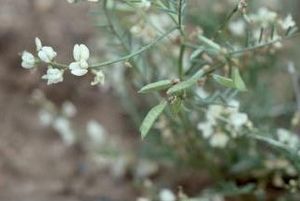Mulford's milkvetch facts for kids
Quick facts for kids Mulford's milkvetch |
|
|---|---|
 |
|
| Conservation status | |
| Scientific classification |
Astragalus mulfordiae is a special kind of flowering plant. It belongs to the legume family, just like peas and beans! People often call it Mulford's milkvetch. It got this name from the person who discovered it, Anna Isabel Mulford.
This plant naturally grows in the Snake River Plain. This area is found in the states of Idaho and Oregon in the United States.
Contents
What is Mulford's Milkvetch Like?
This plant is a perennial herb, which means it lives for more than two years. It can grow up to 25 or 30 centimeters tall. That's about the length of a school ruler! It has thin stems.
Leaves and Flowers
The leaves of Mulford's milkvetch are green or yellow-green. Each leaf has several pairs of smaller leaflets. The biggest leaflets are about 1.1 centimeters long.
The flowers grow in a cluster called a raceme. Imagine a stalk with many flowers blooming along its sides. Up to 20 flowers can be found in one cluster. These flowers have white petals. Sometimes, the petals might have stripes or a hint of purple color.
Fruits and Seeds
After the flowers, the plant produces a fruit. This fruit is a type of legume pod. It can grow up to 1.6 centimeters long. Inside each pod, you can find up to 16 seeds.
Where Does Mulford's Milkvetch Live?
This plant likes to grow in very dry and cold desert areas. These areas are part of the western Snake River Plain. Its home is often called a shrubsteppe. This means it's a place with lots of shrubs and grasses.
Plant Neighbors
In these desert shrub communities, Mulford's milkvetch grows alongside other plants. You might find it near Purshia tridentata, which is also known as bitterbrush. It also grows with Stipa comata, a type of grass.
Facing Challenges
Even though this plant is tough, it faces some challenges. Some groups of these plants can handle changes in their environment better than others.
Threats to the Plant
Sadly, some populations of Mulford's milkvetch have disappeared from certain areas. This can happen because of too much grazing by animals like cattle. However, some groups of plants can actually grow well even when cattle are around.
Other dangers for this plant include wildfires. Also, off-road vehicles can damage their habitat. Another big problem is when plants from other places, called invasive species, start to grow where they don't belong. One example is Onopordum acanthium, also known as Scotch thistle, which can take over the space Mulford's milkvetch needs.


